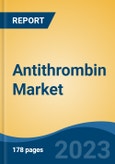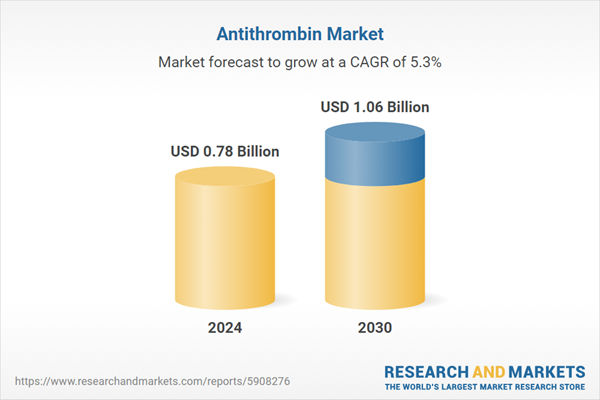Speak directly to the analyst to clarify any post sales queries you may have.
10% Free customizationThis report comes with 10% free customization, enabling you to add data that meets your specific business needs.
Key Market Drivers
Rising Prevalence of Thrombotic Disorders
Thrombotic disorders, marked by the formation of blood clots within the circulatory system, are a significant global health threat. As the incidence of these conditions rises, so does the demand for effective treatments. Antithrombin products are becoming essential in the management and prevention of thrombotic events.Thrombotic disorders include DVT, PE, stroke, and DIC, which can lead to severe complications, such as organ damage and death. According to the World Health Organization (WHO), thrombosis is a major contributor to global morbidity and mortality. In the U.S., the Centers for Disease Control and Prevention reports that venous thromboembolism (VTE) affects up to 900,000 people annually, with 60,000 to 100,000 deaths attributed to the condition each year.
Additionally, many individuals experience long-term complications. Risk factors for thrombotic events include advanced age, sedentary lifestyles, obesity, diabetes, cancer, cardiovascular disease, and genetic predisposition. Major surgeries, particularly orthopedic, cardiovascular, and gynecological procedures, also increase the risk of clot formation. As a result, antithrombin products are often used prophylactically in these high-risk scenarios.
Antithrombin, a natural protein in the bloodstream, regulates the clotting process by inhibiting key clotting factors, including thrombin and factor Xa. When antithrombin levels are deficient or impaired, the likelihood of clot formation increases. Consequently, the growing prevalence of thrombotic disorders is driving increased demand for antithrombin products, both for prevention and treatment. The rise in surgical procedures and the need for antithrombin therapy for patients experiencing thrombotic events further contribute to market growth. The increasing need for advanced antithrombin therapies, such as recombinant products, is also fueling research and development in the market.
Key Market Challenges
Limited Awareness and Diagnosis
One of the significant challenges facing the antithrombin market is the lack of awareness about thrombotic disorders such as DVT and PE. These conditions often present with subtle or non-specific symptoms, and many individuals are unaware of their risk factors. Common symptoms, such as leg pain, swelling, or difficulty breathing, are often overlooked or misattributed to less severe conditions, delaying diagnosis and treatment. This lack of awareness hinders timely medical intervention, reducing the demand for antithrombin therapies.Without early detection, thrombotic disorders can lead to severe health consequences, including organ damage, stroke, or death. Therefore, raising awareness of thrombotic disorders, their symptoms, and the importance of early diagnosis is crucial for improving patient outcomes and expanding the market for antithrombin products.
Key Market Trends
Expanding Therapeutic Indications
Historically, antithrombin therapies have been primarily associated with the treatment of thrombotic disorders. However, ongoing research and clinical trials are expanding the potential therapeutic applications of these treatments. For example, antithrombin products are being explored for their role in sepsis, a severe systemic response to infection where blood clotting contributes to organ failure. By targeting the coagulation pathway, antithrombin therapies may help manage sepsis-induced coagulopathy, improving patient outcomes.In February 2022, Grifols partnered with Endpoint Health, Inc. to develop a therapy for sepsis using Antithrombin III (AT-III). This collaboration aims to leverage Grifols' expertise in plasma-protein therapies, with the company serving as the exclusive provider of AT-III.
Antithrombin products are also being investigated for their potential benefits in liver diseases such as cirrhosis and acute liver failure, where blood clotting factors play a key role in disease progression. Additionally, these therapies are being studied as adjuncts to cancer treatments, as tumors can cause coagulation system alterations, increasing the risk of thrombotic events in cancer patients.
The expansion of therapeutic indications presents new opportunities for the antithrombin market. As antithrombin therapies gain recognition in treating a broader range of conditions, such as sepsis, liver diseases, and cancer, the demand for these products is expected to increase, opening new market avenues and enhancing patient outcomes in complex, life-threatening diseases.
Key Market Players
- Grifols, S.A.
- Takeda Pharmaceutical Company Limited
- Octapharma Brasil Ltda.
- LFB USA, Inc.
- Endpoint Health, Inc.
- Siemens Healthineers AG
- Thermo Fisher Scientific Inc
- BioCare, Inc.
- F. Hoffmann-La Roche Ltd
- Kedrion S.p.A
Report Scope:
In this report, the Global Antithrombin Market has been segmented into the following categories, in addition to the industry trends which have also been detailed below:Antithrombin Market, By Usage:
- Therapeutics
- Diagnostics
- Research
- Others
Antithrombin Market, By Source:
- Human
- Recombinant Goat Milk
- Others
Antithrombin Market, By Type:
- Anticoagulant
- Antiplatelet
- Thrombolytic Drugs
Antithrombin Market, By Region:
- North America
- United States
- Canada
- Mexico
- Europe
- Germany
- United Kingdom
- France
- Italy
- Spain
- Asia-Pacific
- China
- Japan
- India
- Australia
- South Korea
- South America
- Brazil
- Argentina
- Colombia
- Middle East & Africa
- South Africa
- Saudi Arabia
Competitive Landscape
Company Profiles: Detailed analysis of the major companies present in the Global Antithrombin Market.Available Customizations:
With the given market data, the publisher offers customizations according to a company's specific needs. The following customization options are available for the report.Company Information
- Detailed analysis and profiling of additional market players (up to five).
This product will be delivered within 1-3 business days.
Table of Contents
Companies Mentioned
- Grifols, S.A.
- Takeda Pharmaceutical Company Limited
- Octapharma Brasil Ltda.
- LFB USA, Inc.
- Endpoint Health, Inc.
- Siemens Healthineers AG
- Thermo Fisher Scientific Inc
- BioCare, Inc.
- F. Hoffmann-La Roche Ltd
- Kedrion S.p.A
Table Information
| Report Attribute | Details |
|---|---|
| No. of Pages | 180 |
| Published | February 2025 |
| Forecast Period | 2024 - 2030 |
| Estimated Market Value ( USD | $ 0.78 Billion |
| Forecasted Market Value ( USD | $ 1.06 Billion |
| Compound Annual Growth Rate | 5.2% |
| Regions Covered | Global |
| No. of Companies Mentioned | 10 |









